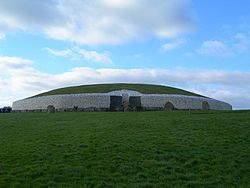Brú na Bóinne

Newgrange passage grave
|
|
| Location | valley of the River Boyne |
|---|---|
| Region | County Meath, Ireland |
| Coordinates | 53°41′34″N 6°26′58″W / 53.69284°N 6.44932°WCoordinates: 53°41′34″N 6°26′58″W / 53.69284°N 6.44932°W |
| Area | 780 hectares |
| Type | Cultural |
| Criteria | i, iii, iv |
| Designated | 1993 (17th session) |
| Part of | Brú na Bóinne - Archaeological Ensemble of the Bend of the Boyne |
| Reference no. | 659 |
| Ireland | |
| Region | Europe and North America |
Brú na Bóinne (Irish: [ˈbˠɾˠuː n̪ˠə ˈbˠoːn̪ʲə], Palace of the Boyne or Mansion of the Boyne) is an area in County Meath, Ireland, located in a bend of the River Boyne. It contains one of the world's most important prehistoric landscapes dating from the Neolithic period, including the large Megalithic passage graves of Knowth, Newgrange and Dowth as well as some 90 additional monuments.
Since 1993 the site has been a World Heritage Site designated by UNESCO, known since 2013 as "Brú na Bóinne - Archaeological Ensemble of the Bend of the Boyne".
The area is located eight kilometers west of Drogheda in County Meath, Ireland, in a bend of the River Boyne. It is around 40 kilometers north of Dublin.
As well as being surrounded on its southern, western and eastern sides by the Boyne, one of the Boyne's tributaries, the Mattock, runs along the northern edge, almost completely surrounding Brú na Bóinne with water. All but two of the prehistoric sites are within this river isthmus.
The area has been a centre of human settlement for at least 6,000 years, but the major structures date to around 5,000 years ago, from the Neolithic period.
The site is a complex of Neolithic mounds, chamber tombs, standing stones, henges and other prehistoric enclosures, some from as early as 35th century BC - 32nd century BC. The site thus predates the Egyptian pyramids and was built with sophistication and a knowledge of science and astronomy, which is most evident in the passage grave of Newgrange. The site is often referred to as the "Bend of the Boyne" and this is often (incorrectly) taken to be a translation of Brú na Bóinne (Palace or Mansion of the Boyne). The associated archaeological culture is often called the "Boyne culture".
...
Wikipedia

